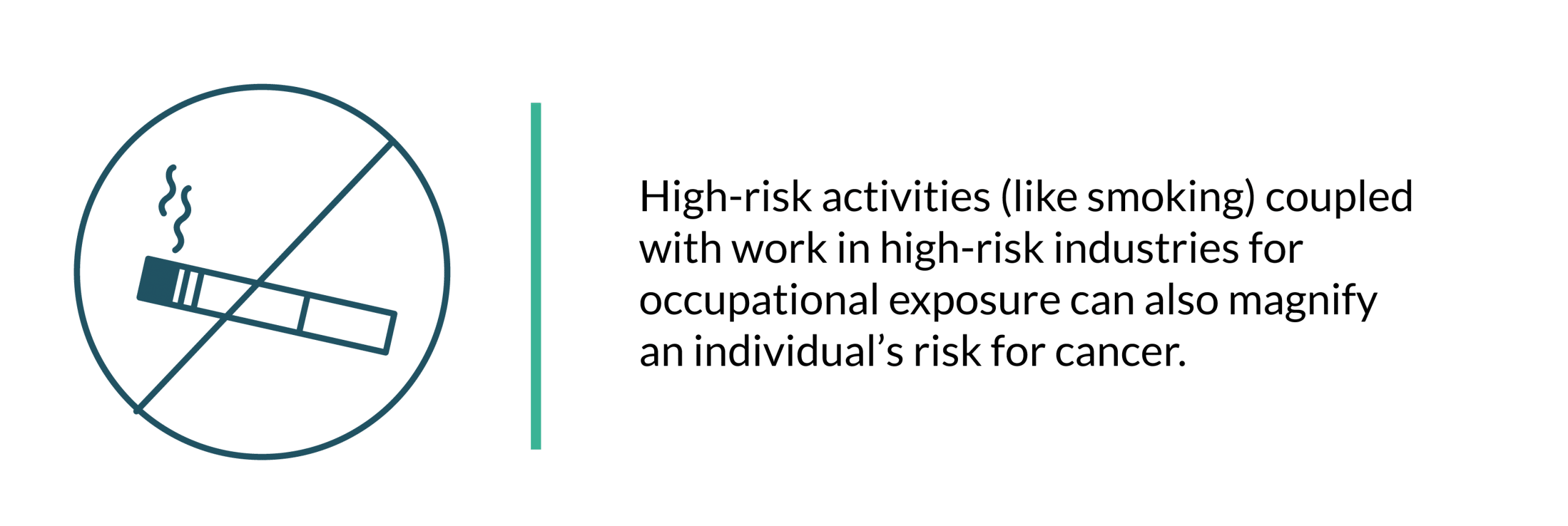Lung Cancer Prevention
The primary method of lung cancer prevention is quitting or never smoking cigarettes but reducing other risk factors and increasing protective factors can improve odds.

Lung Cancer Causes & Prevention
Lung cancer (an often-deadly and fast-spreading group of cancers) is the number one cause of cancer death worldwide. In the U.S., more than 1.8 million people will be diagnosed with the disease in 2020. While smoking cigarettes is the leading cause of a majority of lung cancers, the rate of lung cancer in people who never smoked is high enough to form its own category among the top 10 causes of cancer death in the country. Due to a large number of lung cancers among never-smokers, research into identifying causes and risks for lung cancer prevention is growing.
High-Risk Lung Cancer Industries
High-risk activities (like smoking) coupled with work in high-risk industries for occupational exposure can also magnify an individual’s risk for cancer. Subsequently, chronic and often fatal diseases like lung cancer, leukemia, and mesothelioma are the most common work-related cancers.

Clinical trials are currently underway to study new techniques and medications to prevent cancer in the lungs. These trials may accept healthy individuals of several age groups or certain populations with a high risk of developing lung cancer.
How to Prevent Lung Cancer
According to the American Cancer Society, not all types of lung cancer can be prevented due to factors outside of your control (such as genetics). Individual characteristics that increase a person’s chance of getting cancer are known as risk factors. Prevention of lung cancer means reducing these risks as much as possible. Risk factors for lung cancer include:
| Beta carotene supplements in heavy smokers | Instead of reducing a person’s risk, heavy smokers who take beta carotene supplements can increase their chances. |
| Exposure to carcinogens | Known cancer-causing agents like asbestos, carbon monoxide, coal, and diesel fumes are major risk factors for environmental and occupational disease. |
| Family history of lung cancer | If you have a parent, sibling, or child with lung cancer, you have an increased risk. |
| HIV infections | Those infected with the human immunodeficiency virus are twice as likely to develop lung cancer. |
| Prior chest radiation therapy | Radiation exposure increases the risk for lung cancer, including radiation for chest x-rays and other imaging tests. |
| Smoking cigarettes and secondhand smoke | Smoking or inhaling smoking from another’s cigarettes are the major risk factors for lung cancers. |
Limiting the potential damage caused by the above risk factors can aid in lung cancer prevention. Likewise, there are several behaviors capable of decreasing a person’s risk, known as protective factors. Protective factors for reducing the risk for developing cancerous tumors in the lungs include:
- Avoid secondhand smoke
- Eating fruits and vegetables
- Lowering occupational exposure
- Never starting smoking
- Almost daily physical activity
- Quitting smoking
- Testing home for radon
Reducing Occupational Risks for Lung Cancer
Exposure to carcinogens on the job causes thousands of workplace illnesses each year. The World Health Organization reports over 200,000 work-related cancer deaths each year; one in ten lung cancer deaths is caused by risk factors at work. Moreover, 1.3 million American workplaces have heightened, hazardous levels of dust, smoke, gas, and vapors.
Carcinogens commonly linked to a higher risk for lung cancer among workers include materials and manufacturing processes like:
- Aluminum production
- Arsenic
- Asbestos
- Beryllium
- Cadmium
- Chromium
- Coal and tar pitch
- Coal gasification
- Coke production
- Crushed silica
- Diesel engine exhaust
- Hematite mining
- Iron and steel foundries
- Nickel
- Painting
- Plutonium
- Radon
- Soot
- Sulfur mustard
As such, over five million workers must wear masks or respirators to prevent inhaling or ingesting toxins. However, these lung cancer prevention methods are only effective when utilized properly and regularly.
As stated above, the combination of smoking and exposure to any known carcinogen can greatly increase a person’s lung cancer risk. Quitting smoking before the development of tumors allows damaged lung tissues the opportunity to repair. Consequently, staying away from cigarettes is one of the best lung cancer prevention methods for current smokers, former smokers, and non-smokers alike.
Early Lung Cancer Screening
When lung cancer prevention methods fail and doctors believe a person is at high risk, screening becomes the next step in prevention. Typically, screening is used to prevent lung cancers from developing into advanced-stage cancers with an extensive spread of tumors throughout the body.
Low-dose chest computed tomography scans (also known as low-dose CTs or LDCTs) use a minimal amount of radiation to search the lungs for nodules or tumors. If caught early, these tumors may be removed via surgery without further treatment.
